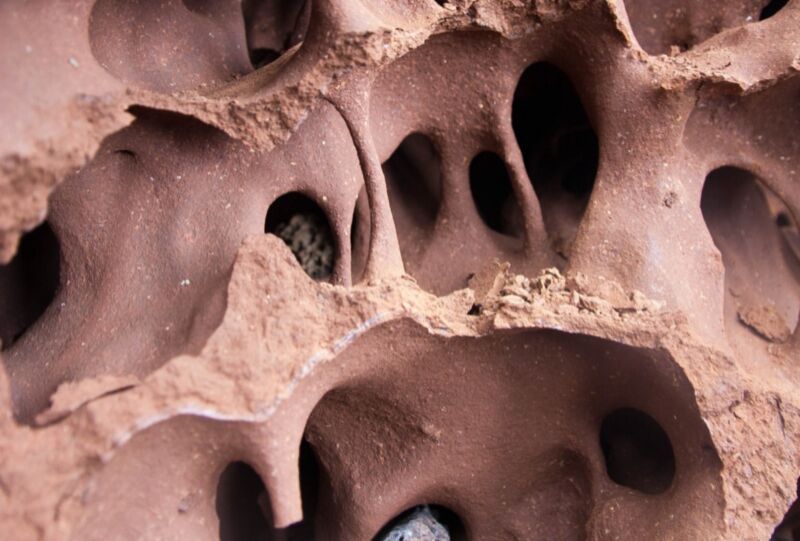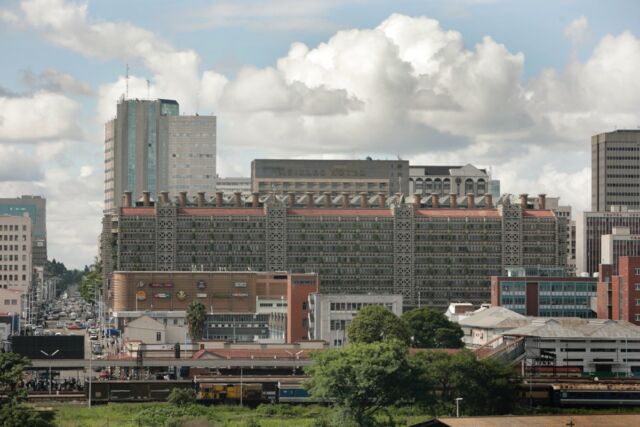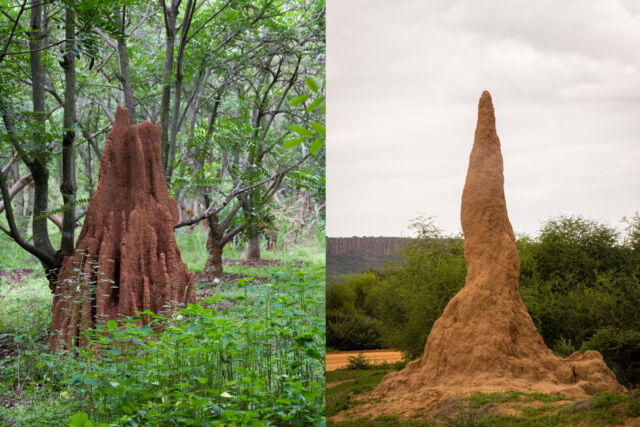
D. Andreen
The mounds that certain species of termites build over their nests have long been thought of as a kind of built-in natural climate control — an approach that has intrigued architects and engineers eager to design greener, more energy-efficient buildings that mimic these principles. Decades of research have been devoted to modeling how these nests function. A new paper published in the journal Frontiers in Materials provides new evidence for an integrated system model in which the mound, nest and its tunnels work together, much like a lung.
Perhaps the most famous example of the influence of termite mounds in architecture is the Eastgate Building in Harare, Zimbabwe. It is the country’s largest commercial and shopping complex, yet it consumes less than 10 percent of the energy consumed by a conventional building of its size because there is no central air conditioning and only a minimal heating system. Architect Mick Pearce famously based his design in the 1990s on the cooling and heating principles used in the region’s termite mounds, which serve as fungal nurseries for the termites. Mold is their primary food source.
The conditions must be just right for the fungus to thrive. So the termites must maintain a constant temperature of 87°F in an environment where outside temperatures range from 35°F at night to 104°F during the day. Biologists have long suggested they do this by building a series of heating and cooling vents in their mounds, which can be opened and closed during the day to keep the temperature inside constant. The Eastgate Building relies on a similar system of well-placed vents and solar panels.

There are different types of termite mounds depending on the species, which makes identifying universal ones a bit tricky. For example, in 2019, scientists at Imperial College London studied the mounds of another type of African termite common in Senegal and Guinea. This species does not breed mold, so their mounds lack the distinctive chimneys and window-like openings of Zimbabwe’s termite mounds that inspired Pearce’s design for the Eastgate Building. There are no visible openings at all. Instead, there are pores, the natural result of how the mounds are made: by piling grains of sand mixed with termite spit and soil. It is these pores that help the structure to “breathe” and also dry out faster after heavy rains.
In the case of Zimbabwe’s termite mounds, the precise mechanism has long been a matter of debate. Is it some form of induced flow (also known as the “stack effect”), the fact that heat from the colony inhabitants drives air up and out through the mound’s vents (thermosiphon flow), or a combination? Or maybe a different kind of model is needed.
Physiologist Scott Turner of SUNY-Syracuse and Rupert Soar of Nottingham Trent University co-authored a 2008 paper alleging that Pearce had relied on false assumptions when he designed the Eastgate building. In particular, there is no solid evidence that termites regulate the temperature of their nests. Pearce’s design was nevertheless a success, but Turner and Soar envisioned “buildings that are not only inspired by life – biomimetic buildings – but that are, in a sense, as alive as their inhabitants and the living nature in which they are embedded .”
This latest paper by Soar and David Andréen of Lund University in Sweden examines an alternative hypothesis first proposed by Turner in 2001. In this scenario, the termite mound is part of a larger integrated system that includes the subterranean nest and complex lattice-like network of excavated tunnels known as the “exit complex” that could act as an engine for selective air currents. Turner envisioned this system as a functional analog of a lung, letting oxygen in and carbon dioxide out. In practice it is a multi-phase gas exchanger.

D. Andreen
The termites are also able to evaporate excess water more quickly after it rains by transporting and depositing the water around the exit tunnels. Those tunnels are most strongly ventilated by the wind, accelerating evaporation without disturbing the oxygen/CO2 balance in the nest.
Soar and Andréen wanted to demonstrate that the exit complex can be used to promote air, heat and moisture flows in architectural design. “When ventilating a building, you want to maintain the delicate balance between temperature and humidity inside, without impeding the movement of stale air out and fresh air in,” says Soar. “Most HVAC systems struggle with this. Here we have a structured interface that allows for the exchange of breathing gases, driven simply by concentration differences between one side and the other. The conditions inside are thus preserved.”

